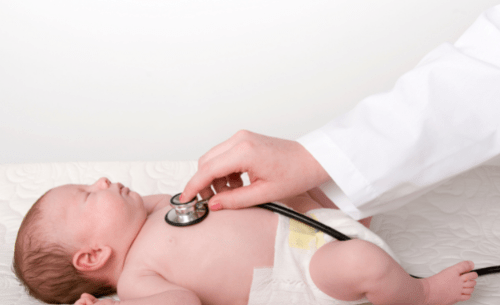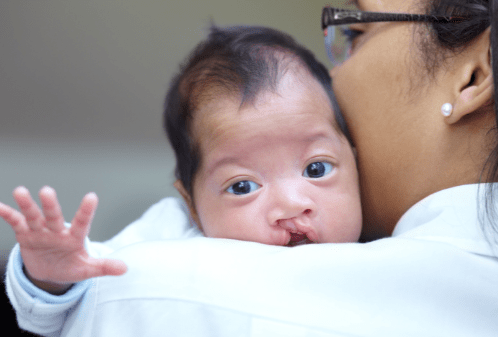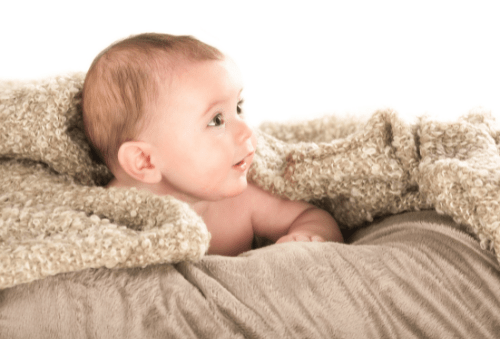Sudden infant death syndrome (SIDS) is the unexpected passing of a seemingly healthy and balanced newborn under the age of one year. Because babies tend to die in their baby cribs, SIDS is sometimes known as crib death.
Although the cause is unknown, a study found that SIDS may be linked to difficulties in a newborn’s brain region that controls breathing and rest arousal.
Some elements have been discovered that may put newborns at an increased risk. They’ve also identified methods to help you safeguard your kid from SIDS. Putting your infant to sleep on their back is one of the most essential aspects.


Sudden infant death syndrome (SIDS) is the unexpected passing of a seemingly healthy and balanced newborn under the age of one year. Because babies tend to die in their baby cribs, SIDS is sometimes known as crib death.
Although the cause is unknown, a study
found that SIDS may be linked to difficulties in a newborn’s brain region that controls breathing and rest arousal.
Some elements have been discovered that may put newborns at an increased risk. They’ve also identified methods to help you safeguard your kid from SIDS. Putting your infant to sleep on their back is one of the most essential aspects.
Table of Contents
What Is Sudden Infant Death Syndrome (SIDS)?
Sudden Infant Death Syndrome (SIDS) is the unexpected, inexplicable death of an infant under one-year-old that isn’t explained after a complete investigation. This involves performing a full autopsy, looking at the death scene, and reviewing the scientific history.
When a baby dies, medical insurance carriers, cops, and communities seek to discover what caused it. They ask questions, examine the baby, gather data, and perform tests to determine why they died. When the cause of death cannot be determined, and if the kid was younger than one year old, the clinical inspector or coroner will certainly declare SIDS.
When the cause of death is wholly inexplicable, the clinical supervisor or edge may leave it as “unidentified” if there remains some unpredictability regarding the reason.
Background of SIDS
In 1994, the National Institute of Youngster Wellness and Person Development (now known as the Eunice Kennedy Shriver Centre) led “Back to Rest,” a campaign to inform moms and dads about SIDS and its risk factors.
The campaign was inspired by a 1992

American Academy of Pediatrics (AAP) recommendation that stated babies were safest when sleeping on their backs or sides. The AAP recommends using the Back Sleepers’ Defense, and this advice was changed to say that just the rear position is safe. The “Safe to Sleep” program is precisely the same as in 1997.
In 1992, there were 120 SIDS deaths per 100,000 live births in the United States. SIDS mortality decreased by 53% from 1992 to 2001 in the United States. SIDS deaths per 100,000 births have continuously reduced for many years and dropped to as low as 40 in recent years. The rise in the number of parents who put their babies in the back sleeping position has been linked to a drop in SIDS cases.
On the other hand, SIDS is still the most common cause of death for newborns between 28 days and one year old. In addition, several statistical research has discovered differences in race and ethnicity among them.
According to studies of moms from various races and ethnicities, there are several anomalies when it comes to co-sleeping with babies, putting infants on their backs for sleep, and utilizing soft bedding in cribs. Another possibility is that the cost of rental space was prohibitively expensive. Families with more than one kid may resort to crib-sharing or bed-sharing to save room, for example, owing to limited financial resources.
Young males are considerably more likely to die of SIDS than infant ladies. Historically, it was believed that babies were at a greater risk of SIDS during the colder months of the year. Still, current data reveal that SIDS deaths are distributed relatively equally across warmer and colder months.
Current Development of SIDS
The number of children who die suddenly in their cribs in the United States is about 4,000 per year. Nearly half of these are labeled as SIDS or uncommon, while the other half is attributed to various reasons.
The words “sudden crib death” have grown increasingly difficult to comprehend in recent years, not just for parents but also for doctors and researchers.
According to the CDC (Center for Disease Control), to ease concerns, SUID (Sudden Unanticipated Infant Death) was recommended as a general phrase that includes all unexpected infant deaths.
The Center for Disease Control and Prevention classifies these as follows: SIDS (Sudden Infant Death Syndrome), unintentional deaths (such as suffocation and strangulation), sudden natural fatalities (such as those caused by infections, heart or metabolic issues, and also neurological diseases), and murders are all examples of this.
However, several others, such as the Sudden Infant Death Syndrome (SIDS), use SUID to suggest inexplicable infant death. Even after a comprehensive examination of the scene, a medical inspector cannot distinguish between SIDS and suffocation; they will frequently employ this phrase to imply it is inexplicable.
Many other medical supervisors may consider their tasks “obscure,” while others would still refer to them as SIDS.
The scene examination is critical because there is generally no other method to tell apart suffocation and SIDS at a postmortem examination. Investigators are utilizing doll reenactments at home to assist parents in understanding the circumstances surrounding their children’s death.
How is SIDS Diagnosed?
SIDS is diagnosed when the cause of death is unusual following a comprehensive investigation. Following are the steps in an investigation:
➣ Take a look at the body after fatality.
➣ Checking out where the fatality happened.
➣ Assessing the baby’s symptoms or diseases before death.
➣ Any other relevant wellness background.
Cause of SIDS
SIDS death is a mysterious disease. The reasons for SIDS are still unclear, and research continues. Certain factors make infants more prone to SIDS; some risk factors are avoidable, while others are not. It’s been proven that some children who die from SIDS have one or more of the following:
Brain Abnormalities
Certain SIDS infants risk dying prematurely in the first year of life due to genetic or structural brain defects. Exposure to a hazardous compound or a loss of oxygen during pregnancy might cause these issues.
The amount of oxygen the unborn baby receives is determined by several factors, including smoking cigarettes during pregnancy.
Occasions After Birth
Sudden infant death syndrome (SIDS) is when an infant suffocates suddenly, usually while sleeping. Events such as decreased oxygen, too much CO2 consumption, overheating, or an infection may be linked to SIDS.
The following are examples of when there are not enough oxygen and also excessive carbon dioxide levels:
When infants do not get enough air, their bodies typically react by causing them to wake from sleep and cry. Changes in heart rate or breathing patterns are made to counteract the decreased oxygen and increased carbon dioxide. A baby with a mind abnormality may not be able to utilize this ability to safeguard themselves, though.
This could explain why infants who sleep on their tummies are at a higher risk of dying from SIDS and why a lot of SIDS fatalities have been linked to respiratory infections before death. This might also explain why more SIDS cases occur during the year’s colder months when respiratory viruses and digestive illnesses are far more likely.
Breathing Infections that Cause Breathing Issues
Infants spend a lot of time on their bellies, so the bedding and sheets trap breath exhaled air (with carbon dioxide) and trapped carbon dioxide in the sleep environment.
Immune System Issues
Some SIDS babies’ immune systems have been said to create more than usual quantities of cells and healthy proteins. Several of these proteins might alter mood and breathing during sleep or put the youngster into a deep sleep. Such findings may be strong enough to induce the infant’s death, especially if the baby has a neurological problem.
Metabolic Condition
The death of an infant may be caused by metabolic disease. These infants can create extremely abnormal proteins, which might result in a rapid and fatal disruption in breathing and cardiac function.
If there is a family history of these diseases or childhood fatality from an unknown cause, blood tests done on the parents by a doctor may reveal whether they are carriers. If both parents are discovered to be carriers, the newborn can be examined not long after birth.
Risk Factors for SIDS
The following factors have been linked to a higher risk of SIDS in infants:
Side or Belly Resting
Scientists have linked sleep position and SIDS for a long time. Hypercapnia, carbon dioxide formation, hypoxia, and a lack of oxygen in the cells are all increased when infants sleep on their tummies or sides.
Resting on the stomach also helps reduce the baby’s rate of warm loss and raises their body temperature, causing them to overheat. Furthermore, resting the belly reduces the efficiency of the cardiovascular system. Being placed on one’s side is also dangerous, as babies are more likely to roll onto their tummies when resting on their sides.
According to existing recommendations, newborns should sleep in the supine (back-sleeping) position until they are a year old. This includes nighttime resting as well as daytime naps.
Age
Infants younger than six months old account for most SIDS-related deaths. The danger of SIDS is considered to be between one and four months after birth. Furthermore, preterm infants weighing less than 1500 grams are at a higher risk of SIDS. For premature babies, consistent back sleeping is especially important.
Rest Environment
Infant sleep areas must be on a firm, level surface covered with fitted sheets according to current standards for parents and caregivers. Soft coverings, cushions, toys, or bumper pads should not be permitted in the child’s rest area.
Many babies who die from SIDS are found with their heads covered by bedding. Parents must also ensure no gaps between the baby crib’s edge and the cushion’s edge. The average guideline is to use two fingers; however, this varies based on personal preference.
Bed-sharing
Parents cannot share a bed with their children since adult beds aren’t made larger for child safety and security. The connection between co-sleeping and SIDS remains studied, but it raises the risk of suffocation, falling, and other dangers for children.
Various grown-up mattresses include soft bedding, coverings, or patchworks that may conceal the infant’s head, as well as various other goods that raise the danger of SIDS. However, while infants sleep in a baby crib or bassinet, parents are advised to share a bedroom.
Because SIDS can occur suddenly and babies frequently make little or no noise, moms and dads must be able to watch their children throughout the night. If you stay in a hotel with your baby, it’s critical to discuss the option of sharing a room with them for the first six months.
Cigarette
Smoking cigarettes is considered by virtually every significant epidemiological study of SIDS to be a major risk factor. According to specific research, as much as one-third of SIDS-related fatalities might be prevented if moms stopped smoking entirely while pregnant.
It’s also dangerous to expose a newborn or infant to cigarette smoke. Even if the kid doesn’t smoke in bed, SIDS is still hazardous for babies who share a bed with someone who smokes.
Alcohol
Some research hints have suggested that alcohol use while pregnant may raise the chance of SIDS in newborns. This includes alcohol usage throughout the periods immediately before and following perception, as well as during the first trimester.
Feeding
Infants who drink breast milk are at a lower risk of dying from SIDS than those who do not. Babies who are exclusively nursed are less likely to be infected with pneumonia than babies who consume a bust milk diet combined with formula or nutritious food.
Mommies should not breastfeed on chairs, sofas, or other upright surfaces where they may fall asleep because this is a suffocation risk for infants.
Several SIDS risk factors have not been investigated thoroughly enough to reach a justifiable conclusion. Insufficient bedroom ventilation, for example, has been identified as a possible threat element for SIDS by research; however, more study is needed on this issue.
Who is at Risk for SIDS?

Every year, over 4,500 children in the United States die of sudden infant death syndrome (SIDS). Some youngsters are far more vulnerable than others. SIDS is most likely between 2 and 4 months old; it is especially prevalent among boys; and many deaths occur throughout the fall, winter, and early spring seasons.
The following are some of the factors that might put a newborn at risk of SIDS:
-
- Babies who sleep on their stomach instead of their back.
- Children who sleep on soft surfaces have free bedding and are covered by a lot of blankets
- Children who share a bed with multiple other youngsters or adults
- Mothers who smoke while pregnant (have a three times higher chance of experiencing SIDS)
- Maternal, parental, and additional home-based passive smoking exposure (heightens the risk of SIDS)
- Mommies who were under the age of 20 when they had their first pregnancy.
- Babies born to women who received no or delayed prenatal care
- Early or reduced birth weight infants.
Preventing or Reducing SIDS
There is currently no way to know which infants will perish of SIDS. Nonetheless, there are a few things parents may do to lower the risk of their child dying from SIDS, including:
Prenatal Care
Early and regular prenatal care might help to minimize the risk of SIDS. The mother should not smoke, take medicine or alcohol, or eat anything strange before delivery to ensure that her child does not develop an abnormality that puts him at risk for early death.
These methods decrease the chances of a premature or low birthweight kid, placing the baby at a greater risk of SIDS. After all, if you can’t even tell whether your child is breathing right now, how can you be sure that he’ll respond to your infant sleep training?
Place Your Child on Their Back for Rest, Even at Naptime
According to experts, infants should sleep on their backs rather than on their stomachs or side. In countries where newborns had traditionally slept on their bellies, placing them on their backs to sleep has been found to reduce the number of SIDS cases by as much as a half.
The back-to-sleep method is the most effective way to care for an infant from birth until they can roll over. Although many parents are concerned that placing a child on their back would increase the risk of choking, there is no evidence to suggest that this is true.
If your kid has been diagnosed with gastroesophageal reflux, you should constantly contact their health care professional before raising the head of the crib.
Placing babies on their bellies while awake as well as under guidance.
The shoulders can develop rapidly when an infant is awake and being watched by the caregiver, as well as conditioning the neck and tummy muscles.
Don’t use infant seats, child seats, strollers, infant carriers, or baby swings for routine rest and regular naps; these may obstruct an infant’s respiratory tract or suffocate him. To minimize the risk of strangulation, keep area cribs, cradles, or play yards in hazard-free locations (with no dangling wires or chords).
Correct Bed Linens
Place the baby on a firm cushion or other company surface covered by a fitted sheet. Do not use fluffy blankets or comforters during sleep. Allow the infant to rest on no soft materials, such as a waterbed, sofa, sheepskin, pillow, or other similar items. Avoid using bumpers when your kid is tiny, and do not place soft-packed toys or cushions in the crib with them. These soft materials surround some infants in their cribs.
Temperature Control
Avoid getting too hot. Underdressing, over bundling or covering your infant’s face or head are all signs that you should avoid. You decrease the risk of SIDS by keeping them cool.
Infants should be kept comfortable, yet not to the point that they get too hot. It’s more likely that a feverish baby will fall asleep and be challenging to wake up from. A child’s room temperature should feel pleasant to an adult.
Same Room/ Room-Sharing
Place the infant’s crib or crib in the mom and dad’s space for the first six months. SIDS is reduced when a baby sleeps in the exact location of their mother. On the other hand, the infant should be in their crib.
Avoid Bed-Sharing
Recent clinical research indicates that bed-sharing between mother and kid may alter the mother’s and baby’s sleep patterns. Bed-sharing may have certain benefits (such as encouraging nursing), but no clinical studies demonstrate that it reduces SIDS.
Some research suggests that bed-sharing, under specific circumstances, might increase the risk of SIDS. Bed-sharing with different children or on a sofa with another person has been discovered to increase the risk of SIDS. For feedings and soothing, babies can be brought into the mom’s and dad’s beds for short periods but should be returned to their baby crib for rest.
Twins or other multiples should not sleep together in bed.
Smoke-free Environment
When you are expecting, don’t smoke or allow anybody else to do so. Smoking in pregnancy is a significant risk factor for SIDS. Babies and youngsters exposed to smoking had more colds and other diseases, as well as an increased danger of SIDS.
Pediatric Healthcare and Immunizations
If your youngster appears unwell, contact your medical professional as soon as possible. Parents must bring their children for regular well-baby checkups and booster immunizations. The study does not support the suggestion that vaccines raise the danger of SIDS.
If an infant ever experiences a situation where they stop breathing and goes blue or limp, the cause must be thoroughly investigated.
Breastfeeding Your Baby
Breastfeeding is recommended for at least six months since it is linked to a reduced risk of SIDS and other safety advantages. It would be best if you breastfed your child because bust milk can protect infants against some infections that may cause early death.
To avoid SIDS and sleep-related crib death, do not use cardiorespiratory monitors or industrial tools (wedges, positioners, and other specialized mattresses) while sleeping. The AAP states that no infant positioning devices have ever been revealed to prevent SIDS, although they’ve been studied.
These gadgets, in rare cases, have resulted in infant fatalities. Although specific electronic home displays can detect and sound an alarm system when an infant stops breathing, there is no evidence that such monitors can avoid SIDS. The National Institutes of Health suggested in 1986 that kids who do not have a high risk for abrupt, unexpected death should not be exposed to residential screens.
Providing Pacifiers Throughout Bedtime
The AAP encourages parents to utilize pacifiers during ordinary sleep and naps for the first year of life. Sugar-layered pacifiers are not a good idea, and Pacifiers must be cleaned and replaced regularly. Until breastfeeding has been established, babies should not be started on a pacifier.
Final Thoughts Sudden Infant Death Syndrome
SIDS is a difficult thing to deal with as a new parent. However, there are many things you can do to help reduce the risk of your child dying from it. Follow this article’s tips and ensure you take your child for regular checkups and immunizations. Most importantly, create a smoke-free environment for your family.

